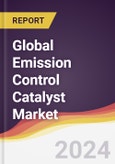In the emission control catalyst market, various technologies, such as diesel particulate filter (DPF), gasoline particulate filter (GPF), diesel oxidation catalyst (DOC), selective catalytic reduction (SCR), and exhaust gas recirculation (EGR) technologies are used. Stringent emission regulations due to increased concern over environmental pollution and increase in the use of automotive diesel engines are creating new opportunities for various emission control catalyst technologies.
This report analyzes technology maturity, degree of disruption, competitive intensity, market potential, and other parameters of various technologies in the emission control catalyst market.
The study includes technology readiness, competitive intensity, regulatory compliance, disruption potential, trends, forecasts and strategic implications for the global emission control catalyst technology by application, technology, and region as follows:
- Technology Readiness by Technology Type
- Competitive Intensity and Regulatory Compliance
- Disruption Potential by Technology Type
Trends and Forecasts by Technology Type [$M shipment analysis from 2018 to 2030]:
- Diesel Particulate Filter (DPF)
- Gasoline Particulate Filter (GPF)
- Diesel Oxidation Catalyst (DOC)
- Selective Catalytic Reduction (SCR)
- Exhaust Gas Recirculation (EGR)
Technology Trends and Forecasts by Application [$M shipment analysis from 2018 to 2030]:
- Transportation
- Diesel Particulate Filter (DPF)
- Gasoline Particulate Filter (GPF)
- Diesel Oxidation Catalyst (DOC)
- Selective Catalytic Reduction (SCR)
- Exhaust Gas Recirculation (EGR)
- Industrial
- Diesel Particulate Filter (DPF)
- Gasoline Particulate Filter (GPF)
- Diesel Oxidation Catalyst (DOC)
- Selective Catalytic Reduction (SCR)
- Exhaust Gas Recirculation (EGR)
- Other
- Diesel Particulate Filter (DPF)
- Gasoline Particulate Filter (GPF)
- Diesel Oxidation Catalyst (DOC)
- Selective Catalytic Reduction (SCR)
- Exhaust Gas Recirculation (EGR)
Technology Trends and Forecasts by Region [$M shipment analysis for 2018 to 2030]:
- North America
- United States
- Canada
- Mexico
- Europe
- United Kingdom
- Germany
- France
- Asia Pacific
- Japan
- China
- South Korea
- India
- The Rest of the World
Latest Developments and Innovations in the Emission Control Catalyst Technologies
Companies / Ecosystems
Strategic Opportunities by Technology Type
Some of the emission control catalyst companies profiled in this report include BASF Catalysts, Johnson Matthey, Solvay, Umicore, Corning Incorporated, and Clariant Corporation.This report answers the following 9 key questions:
Q.1 What are some of the most promising and high-growth technology opportunities for the emission control catalyst market?Q.2 Which technology will grow at a faster pace and why?
Q.3 What are the key factors affecting dynamics of different technologies? What are the drivers and challenges of these technologies in emission control catalyst market?
Q.4 What are the levels of technology readiness, competitive intensity and regulatory compliance in this technology space?
Q.5 What are the business risks and threats to these technologies in emission control catalyst market?
Q.6 What are the latest developments in emission control catalyst technologies? Which companies are leading these developments?
Q.7 Which technologies have potential of disruption in this market?
Q.8 Who are the major players in this emission control catalyst market? What strategic initiatives are being implemented by key players for business growth?
Q.9 What are strategic growth opportunities in this emission control catalyst technology space?
This product will be delivered within 1-3 business days.
Table of Contents
Companies Mentioned
- BASF Catalysts
- Johnson Matthey
- Solvay
- Umicore
- Corning Incorporated
Methodology
The analyst has been in the business of market research and management consulting since 2000 and has published over 600 market intelligence reports in various markets/applications and served over 1,000 clients worldwide. Each study is a culmination of four months of full-time effort performed by the analyst team. The analysts used the following sources for the creation and completion of this valuable report:
- In-depth interviews of the major players in the market
- Detailed secondary research from competitors’ financial statements and published data
- Extensive searches of published works, market, and database information pertaining to industry news, company press releases, and customer intentions
- A compilation of the experiences, judgments, and insights of professionals, who have analyzed and tracked the market over the years.
Extensive research and interviews are conducted in the supply chain of the market to estimate market share, market size, trends, drivers, challenges and forecasts.
Thus, the analyst compiles vast amounts of data from numerous sources, validates the integrity of that data, and performs a comprehensive analysis. The analyst then organizes the data, its findings, and insights into a concise report designed to support the strategic decision-making process.

LOADING...








